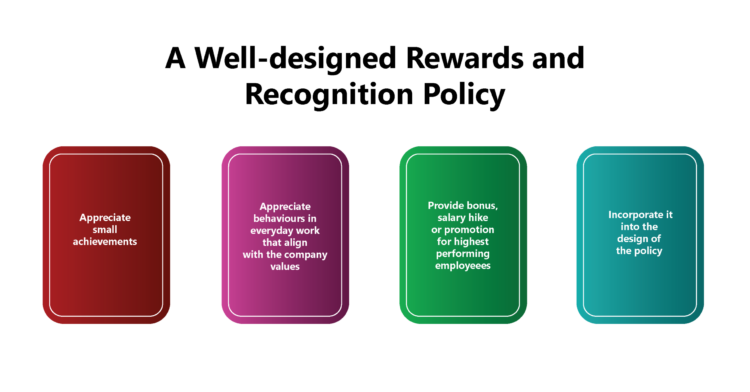1. The “Winner-takes-all” approach may demotivate others: Rewarding only the highest performers with maximum recognition, promotions, or salary increments can demotivate average performers or those on the borderline.
2. Avoiding quota-based or compensatory rewards: However, using a quota system or compensating employees with rewards instead of meaningful recognition or promotions undermines the credibility of the rewards program.
3. Recognize smaller, meaningful achievements: A better approach is to design rewards and recognition policies that appreciate everyday achievements and behaviors aligned with company values, even if they do not directly align with significant performance metrics.
4. Fairness in recognition: Employees who genuinely deserve recognition should receive it. However, it should not be redundant or rewarded in multiple forms for the same achievement, as this can be seen as unfair.
In any organization, typically, the employees who are likely to receive maximum recognition or the highest recognition are the highest-performing ones. It is not surprising that they are the ones who receive the highest salary increments and promotions.

Hence, we need to determine whether the winner-takes-all phenomenon is fair or not.
It seems logical that the highest-performing employees would get the maximum recognition and rewards.
So, the caveat to this is that it might demotivate other employees who are possibly average performers or borderline cases.

The bigger sin by managers or even entire organizations is to use a kind of quota system to ‘allocate’ rewards and recognition to employees.
Also, an employee who is an average performer might end up getting a reward to ‘compensate’ for the lack of a hefty increment or a promotion!
Or vice-versa! Now, this is a cardinal sin! It makes the whole practice of rewards and recognition a total sham!

A more effective approach would be to design rewards and recognition policies that appreciate small achievements and behaviors in everyday work.
These would align with the company values such as customer orientation, innovation, integrity, or initiative – anything small yet significant.

They may or may not be directly linked to the KRAs and, hence, are unlikely to lead to other forms of ‘rewards’ such as a bonus, salary hike, or promotion.
Hence, organizations need to incorporate this into the policy design.

Those employees who deserve recognition should get recognized in any case; however, the employee should not be ‘rewarded’ or ‘recognized’ for the same achievement or behavior in multiple forms. That is not fair!

Lead author: Sagar Chaudhuri, the Co-Founder and CEO of HiFives. He is an HR Tech Evangelist with over 25 years of experience in both corporate and entrepreneurial settings. Previously, Sagar has held leadership roles with companies such as Genpact, Infosys, and ICICI Bank. He has an engineering degree from IIT Kharagpur and an MBA from IIM Lucknow. Connect on LinkedIn
To stay updated on the latest HiFives blogs, follow us on Twitter (@MyHiFives)